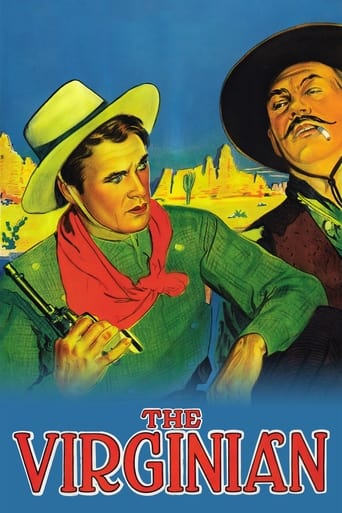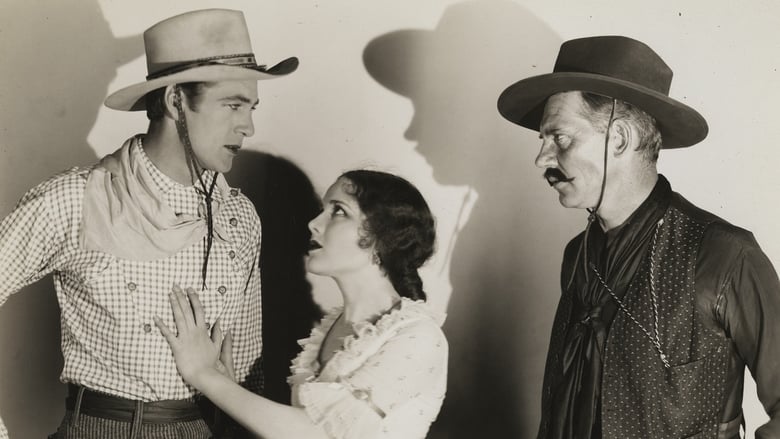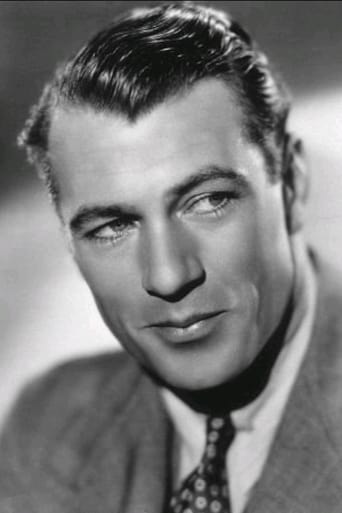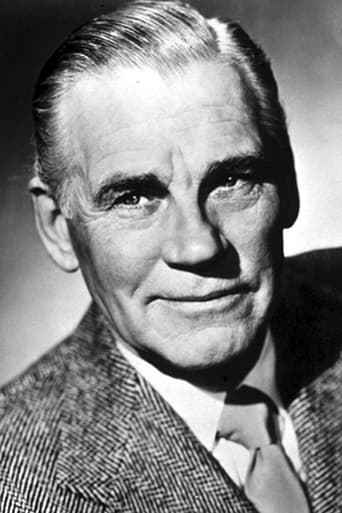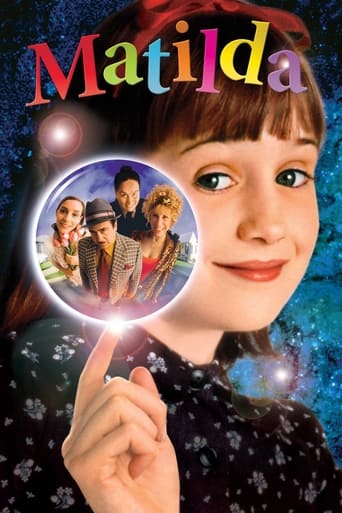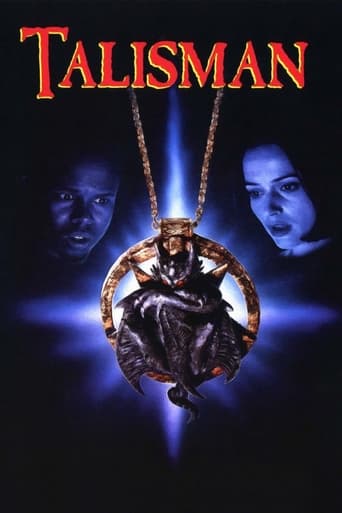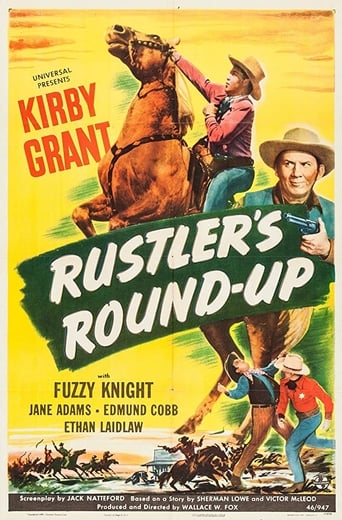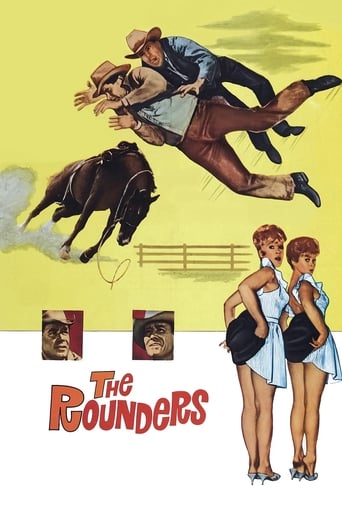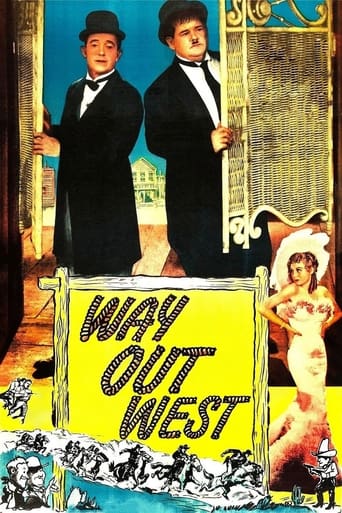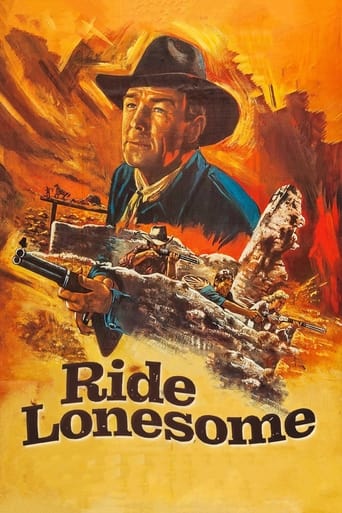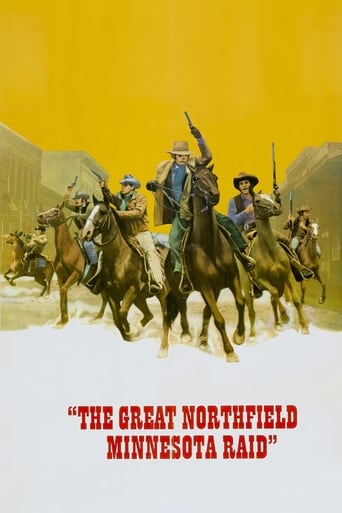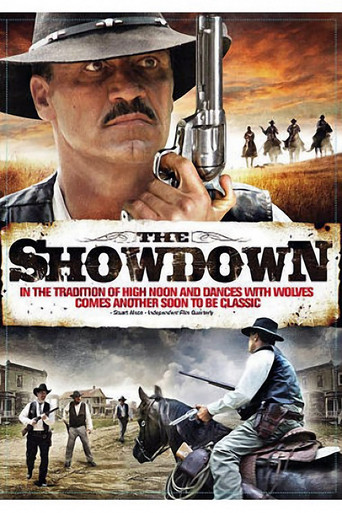The Virginian (1929)
A good-natured cowboy who is romancing the new schoolmarm has a crisis of conscience when he discovers his best friend is engaged in cattle rustling.
Watch Trailer
Free Trial Channels
Cast


Similar titles
Reviews
Overrated
Masterful Movie
It's the kind of movie you'll want to see a second time with someone who hasn't seen it yet, to remember what it was like to watch it for the first time.
I think this is a new genre that they're all sort of working their way through it and haven't got all the kinks worked out yet but it's a genre that works for me.
THE VIRGINIAN (Paramount, 1929), directed by Victor Fleming, from the popular 1902 story by Owen Wister, stars Gary Cooper in his talking movie debut. Having made an impression with theater audiences in a small role from the silent World War drama, WINGS (Paramount, 1927), that earned the distinction of becoming the first Academy Award Best Picture winner, Cooper was soon elevated to leading roles in other silent features, some being westerns, before a whole new career opened for him when his spoken voice was heard for the first time. As the title character, Cooper's success in talkies was assured, even without an Academy Award nomination for a western role that was honored earlier to Warner Baxter playing The Cisco Kid in IN OLD ARIZONA (Fox, 1929).The plot development set in Wyoming introduces the nameless cowboy known to all simply as The Virginian (Gary Cooper) mainly because he's from Virginia. Working as a foreman of the Box H Ranch near Medicine Row, his best pal, Steve (Richard Arlen), a free-spirited cowboy, believes there's a better way to earn money than working. It so happens that, unknown to the Virginian, Steve is connected with Trampas (Walter Huston, in traditional villain role of thick mustache and dark hat) and his gang of cattle rustlers. Arriving from the Union Pacific train is Molly Stark Wood (Mary Brian), the new schoolteacher in town. Her beauty finds The Virginian and Steve rivaling for her affection. At first Molly dislikes The Virginian and devotes her attention to Steve, even with these two acting like little boys playing jokes on one another. Eventually the laughs come to an end as Steve, Pedro (Charles Stevens) and Jim (James Mason) are caught by a posse for cattle rustling, forcing the Virginian to take leadership in their hanging execution the next morning. Before Steve dies, he leaves The Virginian his name engraved gun. Because Trampas is responsible, The Virginian sets out to get him, but on the very day of his wedding to Molly, Trampas threatens the Virginian to leave town before sundown, causing the future groom-to-be faced of being branded a coward or forced to go against Molly's wishes and risk losing her by going on the one on one showdown with Trampas. Others in the supporting cast include: Helen Ware (Mrs. Taylor); Eugene Palette (Honey Wiggen); Chester Conklin (Uncle Hughey); Victor Potel (Nebrasky); George Chandler, Ed Brady and Nena Quartero in smaller roles.Regardless of its age and familiarity, THE VIRGINIAN is an oldie but a goody. "When you call me that, SMILE!" and "Get out of town by sundown" are the film's most famous quotes. Notable scenes include the Virginian and Steve's greeting each other to the whistling sound of a quail; Molly's reaction to her schoolroom of children singing "Three Blind Mice" off-key; Virginian and Steve switching infants in separate room prior to their christening; The Virginian's reaction when having to participate in Steve's execution and hearing an actual quail's whistling prior to it; tense moments between the Virginian and Trampas, among others. Unlike early talkies of the time, THE VIRGINIAN is well paced for 90 minutes, and refrains from actresses, mainly Mary Brian, from overacting in the silent film tradition by allowing her to give a more natural performance. Aside from scenes set in bars or hotel rooms, much of it outdoor scenery appears authentic rather than a closed set with phony painted background. THE VIRGINIAN may seem strange to contemporary viewers where underscoring is non-existent, unless one counts the mooing sounds of cattle steer heard during the opening credit titles. Unlike some early talkies, there's no inter-titles depicting what's to take place in the next scene to come.Next to The Marx Brothers comedy, THE COCOANUTS, THE VIRGINIAN seemingly appears to have been the only other Paramount theatrical release from 1929 made available to broadcast television with frequent revivals in the sixties, seventies and onward, indicating its popularity decades after its initial release. When distributed to video cassette in the early 1990s, the clam-shell box labeled the 1929 edition as the original version, overlooking the fact that there were two earlier silent editions that preceded it: 1914 (Dustin Farnum) and 1923 (Kenneth Harlan). Paramount remade the newly Technicolor and underscored edition of THE VIRGINIAN (1946) starring Joel McCrea, Brian Donlevy and Barbara Britton in the Cooper, Huston and Brian roles, with more emphasis on Molly than on the titled character. THE VIRGINIAN also became the basis of a television series starring James Drury in the 1960s.Unseen on cable television since its presentation on American Movie Classics (1994-1999), THE VIRGINIAN (1929), along with other frequently shown screen adaptations as the 2000 TV movie, turns up occasionally on Encore Westerns, most commonly after sundown where programs directors smile when they do that. (***)
While "The Virginian" is a bit less enjoyable due to it being a very early and old fashioned film, it is worth seeing and helped to make Gary Cooper a star. When I say it's old fashioned, it's because early sound pictures tended to have little incidental music and the films aren't as polished as films made by Hollywood just a couple years later. This is definitely the case with this film...plus like so many later westerns, much of the story creates a mythic version of the West that never actually existed.Soon after the film begins, the new school teacher, Molly, arrives from back East. The Virginian (Cooper) is smitten with her but she is a bit difficult to get to know due to her eastern ways. Eventually, however, they start to like each other...and this is damaged by the Virginian going off on a posse to catch cattle rustlers. This is because one of the rustlers turns out to be his friend, Steve (Richard Arlen)...and Molly blames the Virginian for the posse hanging Steve. However, they soon patch things up and are on the way to a happy marriage...when the leader of the rustlers, Trampas (Walter Huston) arrives in town and promises to shoot the Virginian if he's not out of town by sundown! I strongly doubt that anyone EVER said that in real life....but in films, sure, why the heck not! What's next? See the film.The acting isn't bad but a bit subdued...like ALL films from 1929. They tended to be a bit more stagy than later films but despite its limitations and clichés, this film is quite watchable and well made for the era.
I have to admit, the Western genre usually isn't up my alley, but this one grabbed me when I saw it as a teenager on Christmas break in 1973, and so when I saw it was for sale on DVD-R I bought a copy. My memories did not deceive me - it is still a very good Western whose technique is seemingly unencumbered by the youth of sound technology in 1929.Some things are rather obvious Western clichés, such as the fact that the hero - The Virginian (Gary Cooper) - is always wearing a white hat and generally a light colored shirt. Trampas (Walter Huston), the villain, is always wearing a black hat and black shirt and has a kind of Yosemite Sam black mustache that is so large and cartoonish that Walter Huston is almost unrecognizable underneath it. Steve (Richard Arlen), the Virginian's friend, starts out wearing gray looking clothing. This indicates Steve is no hero but not an outright villain either - he just longs for some easy money. He wears more and more black as Trampas seduces him with the possible big scores of cattle rustling. Then there's the famous line "Smile when you say that" uttered by the Virginian to Trampas. Many people think that line originated here, but it was used in westerns before this. Among those that still exist there's 1925's "Go West" with Buster Keaton being given this command and who would comply if only his facial muscles would let him.However, Paramount, the studio that in the early talkie era employed Lubitsch, Chevalier, and Dietrich and made so many sophisticated precodes was also capable of making one of the best of the early sound westerns. The emotions here are real - including the hanging of some rustlers, some who meet their end with courage and others who meet it with cowardice. Those hanging them are without malice - it is just something they have to do or else they'd be overrun by the lawless and starve to death.Civilized America is symbolized by schoolmarm Molly Stark (Mary Brian), imported from Vermont to teach the pioneers' children and increasingly horrified by the savagery of the place. She just doesn't get that you can't expect some imaginary police force to come to your rescue. The romance between her and the Virginian has many parallels in "High Noon" made 23 years later.Not to say this one is all serious though, there are plenty of laughs to be had especially in the first half of the film. Especially charming and funny is the scene where Molly and the Virginian discuss Romeo and Juliet with the Virginian giving insight into the soul of a pioneer with his interpretation of the story. Then there's Eugene Palette as a cowpoke. Palette like Cooper had been around during the silent era, but the coming of sound increased their value as performers. I'd recommend this to fans of the early talkie whether Westerns are normally of interest to you are not. This is really a good and interesting film.
Although I particularly like the 1946 version of this classic western story with Joel McCrea, this 1929 version of The Virginian has a lot to recommend it, not the least of which is Gary Cooper in the title role.From the first silent version of the story that Cecil B. DeMille directed until a 2000 made for television film that starred Bill Pullman as the cowboy who's only known by the state he originally hails from, this is the story that set the standard for the western novel that has come down to this day. Owen Wister (1860-1938) was a classmate and close friend of Theodore Roosevelt and when the book came out in 1902 it was dedicated to the new president who was in his second term of office.Both Wister and Roosevelt were easterners who had gone west at critical portions of their lives and made careful note of the mores and customs of the people living there. Roosevelt went to the Dakota territory and Wister was in the new state of Wyoming just in time to view the famous Johnson County range war. It certainly was a period where certain folks did make up their own version of the law out in Wyoming and in this Wyoming setting of The Virginian as law and order was usually days if not weeks away, lynching lawbreakers was an accepted if not honored practice.And that's what happens in The Virginian as Gary Cooper catches old friend Steve played by Richard Arlen rustling cattle of the Box H ranch where he is foreman. It's unfortunate that he did not catch gang leader Trampas played by Walter Huston, but the incident sets the scene for the inevitable western showdown.There was western literature before The Virginian, popularized by writers like Ned Buntline. They were called 'penny dreadfuls' as a commentary of their cost and worth. Usually they took real western characters and made up these fantastic unreal stories about them. Real western historians in fact are still trying to separate truth from myth about all these people because of these stories.Wister was a careful chronicler of what he saw and what he saw set the standard for later writers like Zane Grey, Louis L'Amour, Luke Short, etc. All the western clichés we've grown to expect in films got their start right here.The Virginian set the standard in literature and film for a whole genre of entertainment. Any version of the story should not be missed.

